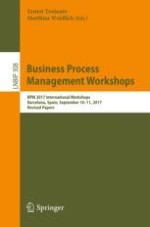2018 | OriginalPaper | Buchkapitel
A Pattern-Based Question Checklist for Deriving Requirements from BPMN Models
verfasst von : Bernhard M. Turban, Johannes Schmitz-Lenders
Erschienen in: Business Process Management Workshops
Aktivieren Sie unsere intelligente Suche, um passende Fachinhalte oder Patente zu finden.
Wählen Sie Textabschnitte aus um mit Künstlicher Intelligenz passenden Patente zu finden. powered by
Markieren Sie Textabschnitte, um KI-gestützt weitere passende Inhalte zu finden. powered by
